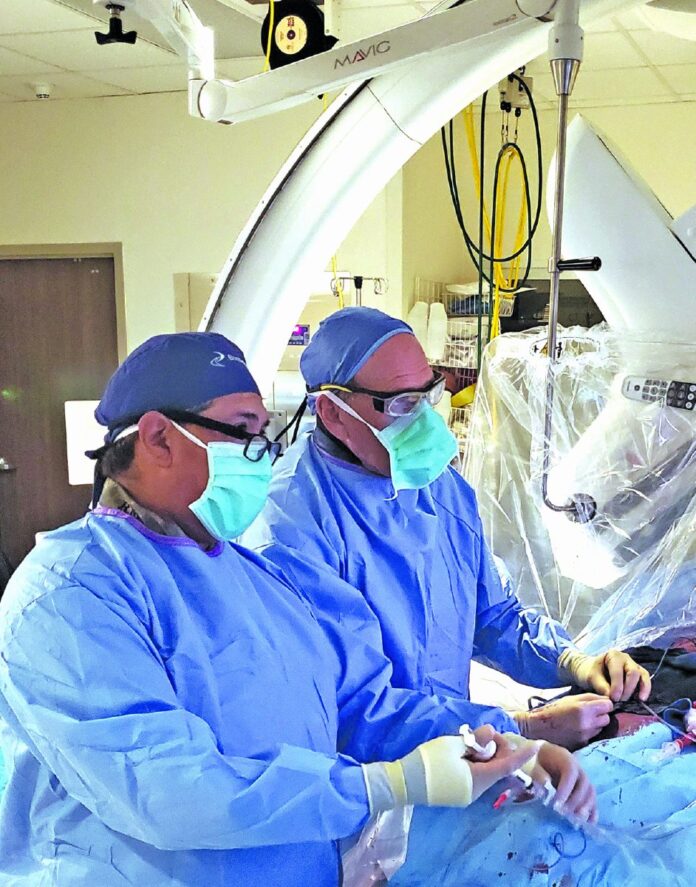HARLINGEN — She’d just gone in for a simple knee replacement, but a stress test revealed something more dire.
“It came back abnormal,” said Sherri MacGowan, 62.
The Port Isabel resident thought she was getting clearance for her knee replacement, but the doctor looked at her chart and said, “No, you’re not, you’re going to the hospital, you’re having a heart cath.”
A heart catheterization involves insertion of a narrow tube into the heart through an artery to examine how well the heart is functioning.
“It turned out that my heart was very clear except I had one little spot that was 85 percent blocked,” she said. “The doctor told me I was due for a big heart attack if I hadn’t gotten it fixed.”
The procedure itself, however, was much less complicated than what she might have received a few months ago. The procedure involved the use of an iFR (instantaneous wave-free ratio), which is used during testing. The new iFR has been available about a year.
“A major benefit regarding the use of iFR is that it is does not require additional equipment or medication, which may be more invasive for the patient,” stated a release from Valley Baptist Medical Center. During the angiogram process, the release stated, a special wire is threaded to the location of a lesion or narrow vessel and placed across the area to take measurements.
The previous fractional flow reserve method provided similar details on lesions and narrow areas in vessels. However, the use of FFR required the use of drugs to dilate a patient’s vessels during the angiogram process, which could be uncomfortable for some patients, the release stated.
“Previously, not all angioplasty trials have shown a benefit to the patient,” said Dr. Charles Mild, cardiologist at Valley Baptist Medical Center where he has been using iFR for about a month.
“The reason for that,” he said, “is that sometimes stents were not always placed in the right lesions. With this new methodology, it’s more positive than ever that we’ve got the right vessel and we’ve found the culprit.”
He explained in more detail the existence of lesions in coronary disease.
“What happens in a heart attack is that you have what are called lesions, atherosclerotic plaque,” he said. “Atherosclerosis is hardening of the arteries. So the plaque builds up and it gets bigger and bigger, and it gets to the point where it ruptures.”
He compared the rupture to a cut on the arm which first bleeds and then forms a clot.
“But if you get a blood clot in the middle of a tube, all of a sudden it blocks it,” he said. “You get no flow. And that’s what a heart attack is. This technique will tell us what blood vessels are likely to rupture and which are not.”
He’s very happy with the iFR.
“It’s hard to say whether we saved any lives but it made people feel better, yes,” he said. “I think it’s great.”
It certainly made Sherry MacGowan feel better.
“I think it was relatively quick,” she said. “When the doctor walked in, they gave me some medicine, and you’re awake, and you can hear and see everything that’s going on but you don’t feel anything. It didn’t seem like it took over five or 10 minutes. And I had no pain involved in it until it was over with and they went to pull the tubing out.”
So while the thought of an angiogram may strike fear in the minds of anyone about to receive one, it appears they’ll have less time to endure it. The comfort zone, in this case a good one, may be expanded even further, reducing significantly the discomfort of the procedure.
Learning More
During the angiogram, interventional cardiologists use tiny catheters, usually inserted through a site via the groin, to inject dye, also known as contrast, into vessels which is easily seen in X-ray imaging. Through use of that imaging, interventional cardiologists can pinpoint lesions or areas of vessels that may be narrowed, causing a wide variety of symptoms from chest pain to shortage of breath. Left untreated, these lesions and narrow areas can cause serious health issues, including stroke and death.
Source: Valley Baptist Medical Center




